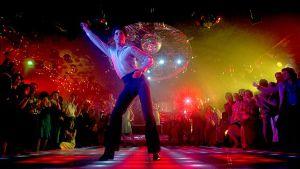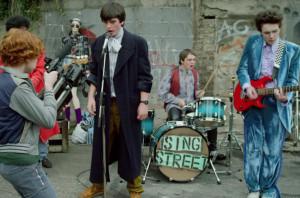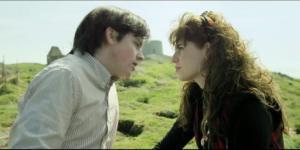Out of all the movies I expected writer-director John Carney’s Sing Street to remind me of, Saturday Night Fever wasn’t one of them. After all, what could the story of a 1980s Dublin band started by a teen boy to impress a girl have in common with the 70s disco dancing exploits of John Travolta?
A lot, as it turns out. Sing Street is more obviously a spiritual sequel to Carney’s prior film-albums Once (2007) and Begin Again (2013), again showcasing his unparalleled knack for perfectly capturing the song creation process on film while brilliantly dramatizing the trials and tribulations which lead to the songs in the first place. More so than either Once or Begin Again, though, Sing Street is a traditional coming of age story, one which frequently evokes one of the titans of that particular genre: Saturday Night Fever.
Not that we always remember that part of Saturday Night Fever. We tend to identify it more by the Bee Gees songs and dance scenes.


More than that, in both films the lead character (Ferdia Walsh-Peelo’s Conor Lalor in Sing Street, Travlota’s Tony Manero in Fever) lives in an area of the world where a clearly better land is actually visible, looming so unattainably large on the horizon while somehow also seeming so tantalizingly close. It makes for that incredibly powerful and richly cinematic moment when the character, clearly yearning for something better from life, can literally point to somewhere in the distance and essentially say, “There. If I can just get there, my dreams might come true.”
In Saturday Night Fever, this is realized through the Verrazano-Narrows Bridge, which connects Brooklyn to Staten Island. That’s the bridge Tony Manero takes his almost-girlfriend (Karen Lynn-Gorney’s Stephanie) to look at while telling her all about how it was built and the daydreams it inspires in him. You can see Manhattan from that bridge, and to a Brooklyn kid in the 70s that was the promise land, the place you wanted to get to but doubted you ever would.


This is the depressing economic backdrop for Conor, whose parents (Aidan Gillen, Maria Doyle Kennedy) are withering under the financial stress and drifting apart, only coming back together long enough to yell at one another. His older brother (Jack Reynor) is a college drop-out stoner who looks like Chris Pratt but acts like Philip Seymour Hoffman’s version of Lester Bangs in Almost Famous. His sister (Kelly Thornton) mostly keeps her head down and focuses on her school work in order to get the grades she needs to become an architect.
Due to the recession, Conor’s parents are forced to cut costs by transferring him to Synge Street, a Christian school where old priests accidentally teach Latin in French class and open brawls go noticed but unbroken up by other priests. There’s a strict taskmasker in charge, and plenty of bullies. Conor has repeated run-ins with both before finally being shown the ropes by a younger student.
As these two bond over shared survival strategies in such a hellhole, Conor notices Raphina, so beautiful and effortlessly cool, standing on a doorstep near the school. If you’ve seen the trailer, you know the rest.
Speaking of which, here is that trailer:
As a trick to get Raphina’s phone number, Conor recruits her to star in his non-existent band’s music video, and then has to turn around and start an actual band and write some songs. Luckily, a flyer on the school bulletin board more or less leads to a full band of misfits, headlined by Conor and his multi-instrumentalist lead guitar player who closely resembles U2’s The Edge (the version from the 80s, not the bald, skull-cap enthusiast we’ve known since the 90s). Thus, the band Sing Street is born.
This is where Sing Street feels more of a piece with Carney’s prior music movies. Watching these kids come together and traipsing around Ireland to film adorably amateurish music videos, for example, is not substantially different from watching Begin Again‘s Mark Ruffalo and Kiera Knightley recording a D.I.Y. album, guerilla style, in found locations throughout New York City.
Similarly, being made to feel like a fly-on-the-wall as we peek in on Conor and his lead guitarist’s songwriting sessions pleasantly recalls watching Glen Hansard and Marketa Irglova sitting down to that music shop piano to compose “Falling Slowly” together in Once.
Familiar or not, I could eat this stuff up all day. There are those who hope Richard Linklater, Ethan Hawke and Julie Delpy keep making Before movies every 9 years for the rest of their lives. I’m all for that, but I also want John Carney to keep making music movies which leave you inspired to chase after that lost love (Once) or say fuck it to a broken/corrupt system (Begin Again) or grab the wheels on your own life and “drive it like you stole it” (Sing Street).
Of the three, Sing Street might actually be my favorite. In fact, it’s my favorite film of 2016 so far (with apologies to Captain America: Civil War).

Carney and the Sing Street cast at Sundance
That’s not to say it is an altogether perfect film. Very few members of the band stand out as memorable characters, probably because Carney mostly cast local, amateur actors who could actually play their instruments. Moreover, by Carney’s own admission the film condenses what would be a 3 or 4 year process of improvement for a garage band (eh, technically, they practice in a living room) into one year. This is why Bono recently raved, “In truth, at the same stage, U2 were not as good as the kids in Sing Street.” As such, the speed at which the band turns into a tight unit with some killer original songs is a tad jarring.
Plus, while the film delightfully plays around with the band’s ever-shifting musical influences (they start out writing an obvious Duran Duran homage, then The Cure, etc., with accompanied fashion changes each time) the actual songs, while always pleasant to listen to, don’t always feel completely true to the period. One ballad (“Up”), in particular, feels more like a cast-off from Once and Begin Again and less like the product of a lovelorn, New Wave-influenced teenager’s mild.
The Saturday Night Fever similarities I highlighted earlier also point to the unavoidable problem that this film’s story is ultimately one which we’ve seen before, bits and pieces here and there in other movies over the years. However, I’ve never seen it done in quite this way before, in that place and at that moment in history.
Really, there is an overall honesty and earnestness to this movie which I simply find impossible to resist. Watching Conor grow as a person as a direct result of his music is a complete joy, and while Raphina might border on Manic Pixie Dream Girl territory her relationship with Conor is the type you root for. Moreover, there is a surprising depth and complexity in the film’s second half, perfectly personified in a fantasy music video sequence where Conor’s naivete and innocence take one fantastic final gasp before dying in the face of an increasingly harsh reality.
THE BOTTOM LINE
To borrow an analogy originally made by The Frame, John Carney’s movies can be viewed as albums, “Once is like a debut album — very personal and made with a lot of heart. Begin Again is the follow-up album after being signed to a major record label — it’s big and more ambitious. And then Sing Street is the album that returns a band to its roots — back to the “sound” of the first album, with more reflection and experience.” It also might just be his best album yet.
ROTTENTOMATOES CONSENSUS

